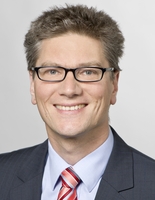Biomedizinische Physik 1
eLearning-Kurs
Zuordnung zu Modulen:
|
| VO |
2 |
Pfeiffer, F.
Mitwirkende: Schaff, F.
|
Mo, 12:00–14:00, virtuell
sowie einzelne oder verschobene Termine
|
Biomedizinische Physik 2
eLearning-Kurs
Zuordnung zu Modulen:
|
| VO |
2 |
Pfeiffer, F.
Wilkens, J.
Mitwirkende: Schaff, F.
|
Mo, 10:00–12:00, virtuell
|
Chemistry in Biomedical Imaging for Physicists
eLearning-Kurs
Zuordnung zu Modulen:
|
| VO |
2 |
Pfeiffer, F.
Mitwirkende: Busse, M.
|
einzelne oder verschobene Termine
|
Biomedical Physics
eLearning-Kurs
Zuordnung zu Modulen:
|
| PS |
2 |
Pfeiffer, F.
Mitwirkende: Schaff, F.
|
|
Blockseminar zu aktuellen Themen in der Biomedizinischen Physik (E17 Seminarwoche)
Zuordnung zu Modulen:
|
| PS |
2 |
Herzen, J.
Pfeiffer, F.
|
|
Modern X-Ray Physics
eLearning-Kurs
Zuordnung zu Modulen:
|
| PS |
2 |
Pfeiffer, F.
Mitwirkende: Achterhold, K.Dierolf, M.
|
|
Seminar zu aktuellen Themen im BioEngineering (MSB-Seminar)
Zuordnung zu Modulen:
|
| PS |
2 |
Pfeiffer, F.
Mitwirkende: Schaff, F.
|
Di, 13:00–14:00, virtuell
|
Übung zu Chemie der biomedizinischen Bildgebung für Physiker
Zuordnung zu Modulen:
|
| UE |
1 |
Leitung/Koordination: Pfeiffer, F.
|
|
BEMP Lab 01: Clinical Computed Tomography
eLearning-Kurs aktuelle Informationen
Zuordnung zu Modulen:
|
| PR |
4 |
Pfeiffer, F.
Mitwirkende: Birnbacher, L.Hammel, J.
|
einzelne oder verschobene Termine
|
Current Research Topics in Biomedical Imaging (E17 Seminar)
Zuordnung zu Modulen:
|
| SE |
2 |
Herzen, J.
Pfeiffer, F.
|
|
FOPRA-Versuch 79: Röntgencomputertomographie
LV-Unterlagen aktuelle Informationen
Zuordnung zu Modulen:
|
| PR |
1 |
Pfeiffer, F.
Mitwirkende: Birnbacher, L.Hammel, J.Viermetz, M.
|
|
Repetitorium zu Biomedizinische Physik
Zuordnung zu Modulen:
|
| RE |
2 |
Leitung/Koordination: Pfeiffer, F.
|
|
Repetitorium zu Moderne Röntgenphysik
Zuordnung zu Modulen:
|
| RE |
2 |
Leitung/Koordination: Pfeiffer, F.
|
|
Repetitorium zu Seminar zu aktuellen Themen im BioEngineering (MSB-Seminar)
Zuordnung zu Modulen:
|
| RE |
2 |
Leitung/Koordination: Pfeiffer, F.
|
|
Seminar of GRK2274
Zuordnung zu Modulen:
|
| SE |
1 |
Pfeiffer, F.
|
|
